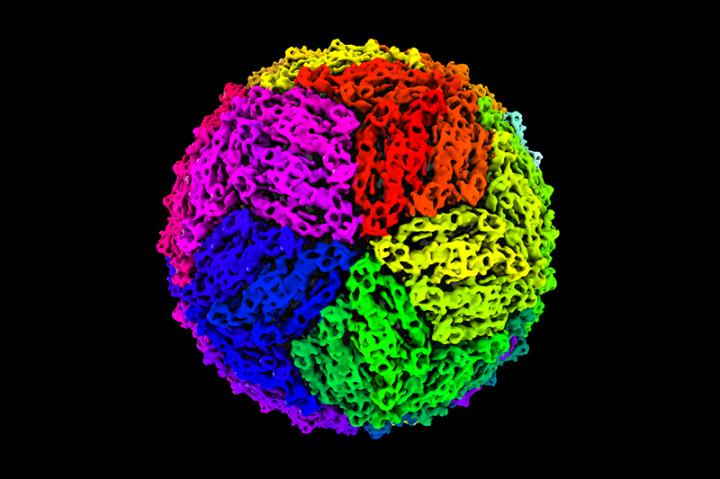Safer viruses for vaccine research and diagnosis

A 3D reconstruction of a chimeric viral particle. Proteins on the virus surface have been coloured using a rainbow gradient to represent the many possible viruses that could be presented using this system. This image, and all of the project's visualizations, were developed by UQ's Dr Daniel Watterson. Credit: Dr Daniel Watterson Usage Restrictions:To be only used with this story. Must be credited.
Researchers from UQ and QIMR Berghofer Medical Research Institute have exploited the benign characteristics of the Binjari virus – inert to humans – to produce 'dangerous looking' mosquito-borne viruses such as Zika and dengue, but which cannot grow in humans or animals.
School of Chemistry and Molecular Biosciences' Dr Jody Hobson-Peters said the team, led by Professor Roy Hall, began to explore this possibility after discovering new viruses in the lab.
“We were originally hoping to gain insights into how mosquito-borne viral diseases evolve – viruses like Zika, yellow fever and dengue,” Dr Hobson-Peters said.
“We were also hoping to discover new viruses that might be useful for biotechnology or as biological control agents.
“The Binjari virus stood out, and while it grows to very high levels in mosquito cells in the lab, it's completely harmless and cannot infect humans or other vertebrate species.
“And it is incredibly tolerant for genetic manipulation, allowing us to swap important genes from pathogenic viruses like Zika, West Nile and dengue into the Binjari genome.
“This produces hybrid, or chimeric, viruses that physically appeared identical to the disease-causing viruses under the electron microscope, but were still unable to grow in human or animal cells.”
The researchers have effectively developed a new biotechnology platform requiring low biocontainment, to help safely develop vaccines and diagnostics against these mosquito-borne diseases.
Professor Andreas Suhrbier, from QIMR Berghofer Medical Research Institute, said the team hoped to push this technology further down the development pathway toward human applications.
“The main advantage of this system is that it is safe,” Professor Suhrbier said.
“These hybrids cannot infect humans, meaning that manufacture of vaccines and diagnostic reagents don't require the strict and expensive biosecurity infrastructure ordinarily needed to grow these pathogenic viruses.
“The research is a testament to collaborative science – this all fell into place, with amazing collaboration within the Australian Infectious Diseases Research Centre.
“It's a technology that will truly revolutionise the manufacture of vaccines – supercharging high-volume vaccine development.”
###
The research has been published in Science Translational Medicine (DOI: 10.1126/scitranslmed.aax7888).
Media Contact
More Information:
http://dx.doi.org/10.1126/scitranslmed.aax7888All latest news from the category: Health and Medicine
This subject area encompasses research and studies in the field of human medicine.
Among the wide-ranging list of topics covered here are anesthesiology, anatomy, surgery, human genetics, hygiene and environmental medicine, internal medicine, neurology, pharmacology, physiology, urology and dental medicine.
Newest articles

Trotting robots reveal emergence of animal gait transitions
A four-legged robot trained with machine learning by EPFL researchers has learned to avoid falls by spontaneously switching between walking, trotting, and pronking – a milestone for roboticists as well…

Innovation promises to prevent power pole-top fires
Engineers in Australia have found a new way to make power-pole insulators resistant to fire and electrical sparking, promising to prevent dangerous pole-top fires and reduce blackouts. Pole-top fires pose…

Possible alternative to antibiotics produced by bacteria
Antibacterial substance from staphylococci discovered with new mechanism of action against natural competitors. Many bacteria produce substances to gain an advantage over competitors in their highly competitive natural environment. Researchers…





















